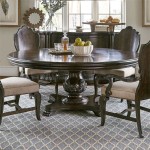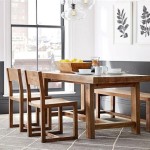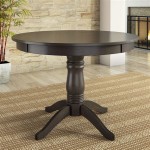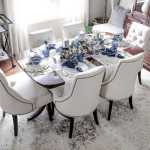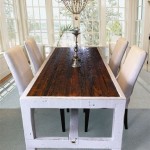Refinishing Dining Room Table Ideas
The dining room table often serves as the heart of a home, a gathering place for meals, conversations, and celebrations. Over time, daily use can take a toll on its finish, leaving it looking worn and dated. Refinishing a dining room table offers an opportunity to revitalize this central piece of furniture, enhancing its aesthetic appeal and extending its lifespan. This article explores various refinishing ideas, providing insights into the process and the possibilities.
Before embarking on a refinishing project, assessing the table's current condition is crucial. This involves examining the existing finish for scratches, dents, watermarks, and other imperfections. Identifying the type of wood, whether solid wood, veneer, or particleboard, will also inform the appropriate refinishing techniques. Understanding the extent of the damage and the type of wood will guide the selection of materials and the complexity of the process.
Choosing the right finish is paramount to achieving the desired aesthetic and durability. Traditional finishes like lacquer, varnish, and shellac offer varying levels of protection and sheen. Lacquer tends to be more durable and resistant to scratches, while varnish provides a warm, amber tone. Shellac, a natural resin, offers a beautiful finish but is less resistant to water damage. Modern options include polyurethane, known for its durability and ease of application, and water-based finishes, which are low in volatile organic compounds (VOCs) and offer faster drying times.
Stripping the existing finish is often the first step in the refinishing process. Chemical strippers can effectively remove old layers of finish but require careful handling due to their potency. Sanding provides a more environmentally friendly alternative, although it can be more time-consuming. Understanding the pros and cons of each method is essential for selecting the most appropriate approach for the specific project.
Sanding plays a vital role in preparing the wood surface for the new finish. Starting with a coarser grit sandpaper and gradually progressing to finer grits will smooth out imperfections and create a uniform surface for optimal finish adhesion. Proper sanding techniques are essential to avoid creating uneven surfaces or sanding through veneers. Dust collection during the sanding process is also important for maintaining a clean work environment and achieving a professional result.
Staining offers an opportunity to transform the color of the dining table, creating a different mood and style. Various stain colors, from light natural tones to rich dark hues, can complement existing décor or create a dramatic focal point. Testing the stain on an inconspicuous area of the table is recommended to ensure the desired color is achieved before applying it to the entire surface. Understanding the wood's natural grain and how it absorbs stain is crucial for achieving a consistent and even finish.
Applying the chosen finish requires patience and precision. Multiple thin coats are generally preferred over a single thick coat to ensure even coverage and prevent drips or runs. Allowing sufficient drying time between coats is crucial for proper adhesion and durability. Following the manufacturer's instructions for application and drying times will yield the best results.
Beyond traditional wood finishes, several creative refinishing ideas can add unique character to a dining table. A distressed finish, achieved through techniques like sanding, scraping, or applying a glaze, can create a rustic or antique look. A two-toned finish, achieved by staining different parts of the table different colors, can add visual interest and highlight specific design elements. Stenciling, painting, and decoupage offer further opportunities for customization and personalization.
Choosing paint as a finish offers a completely different aesthetic. Chalk paint, known for its matte finish and easy application, can create a vintage or shabby-chic look. Milk paint, another popular choice, offers a similar aesthetic with a slightly more durable finish. Using paint allows for bold color choices and the opportunity to create unique patterns and designs.
Incorporating decorative elements can further enhance the refinished dining table. Adding inlay or marquetry, intricate patterns created with different wood veneers, can elevate the table to a work of art. Installing decorative hardware, such as unique handles or pulls, can complement the overall style and add a touch of personality. These details can transform a simple dining table into a statement piece.
Protecting the newly refinished surface is essential for maintaining its beauty and longevity. Using placemats and coasters can prevent scratches and water rings. Regular dusting and cleaning with a damp cloth will keep the surface looking its best. Avoiding harsh chemicals and abrasive cleaners will prevent damage to the finish. Proper care will ensure the refinished dining table remains a cherished centerpiece for years to come.

Refinishing A Dining Table Diy Beautify Creating Beauty At Home

How To Refinish A Table Sand And Sisal

How To Refinish An Antique Dining Set The Wild Decoelis

21 Table Makeover Ideas On A Budget Hometalk

Dining Room Table Makeover

Diy Dining Table Makeovers Before Afters The Budget Decorator

Dining Table Re Makeover White Lane Decor

How To Update An Old Dining Room Table Brepurposed

Diy Refinished Dining Table Top Redhead Can Decorate

Diy Refinished Dining Table Top Redhead Can Decorate

